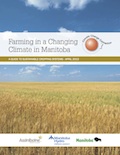 On this page, we deal with these impacts of climate change on crop production:
On this page, we deal with these impacts of climate change on crop production:
Click a link in the list above to jump to that topic on this page.
A changed climate will significantly affect agriculture in Manitoba. Higher levels of CO2, changing rain patterns, higher temperatures and greater occurrence of extreme weather events will all modify crop production in Manitoba.
Climate change is in the forecast however, detailed predictions about how crop production will be affected are less clear. Higher levels of CO2 may affect the growth rate and yield of crops, whereas higher temperatures or lack of precipitation may influence growing season length, crop type, or pests found in fields.1,2
Generally, climate change models predict an uncertain future for agriculture in Manitoba, with potential benefits most likely being offset by major drawbacks.3
The following sections will help clarify the potential benefits and drawbacks of climate change on crop production in Manitoba.
Growing season
Predicted increases in Manitoba’s temperatures could result in a longer growing season due to more frost-free days and earlier seeding times for most crops. For every 1oºC increase in average temperature, the growing season could lengthen by 10 days on the Canadian Prairies.4
Warmer winter temperatures could either reduce the amount of winterkill in fall-seeded crops, or decrease the thickness of snow cover and result in greater amounts of winterkill when cold temperatures are experienced.5
Crop yield
Warming temperatures, particularly higher spring temperatures, mean that crops may be planted earlier. In Alberta, spring is arriving approximately 26 days earlier than it was a century ago. Earlier seeding could mean increased yields in regions where there is adequate soil moisture, due to greater crop growth during spring rains. However, the forecasted reduction in precipitation could result in more frequent drought conditions and loss of yield.6
Crop yield may also be influenced by the increased amount of CO2 in the atmosphere. Crop species vary in their response to CO2 levels:
- C3 plants, such as wheat, canola, and soybeans, as well as many pasture grasses and forage species (i.e. alfalfa, clover, fescue, Kentucky bluegrass) grow better when CO2 levels are higher.
- C4 plants, such as corn, millet, and big bluestem are less responsive to higher CO2 levels.7,8
However, C4 plants have an advantage with higher temperatures, metabolizing CO2 better when temperatures are over 32oC.9 Field trials in Illinois have found there may be negligible growth effects on plant species at higher atmospheric CO2 levels.10
Water resources
Although overall growing season precipitation on the Prairies is expected to decrease, (especially into Alberta) precipitation is anticipated to occur in intense events. Crops depend on the quantity and timing of precipitation, meaning that water stress during a critical growth phase may be detrimental to yield goals. Warmer temperatures and longer dry spells between rain events will likely increase drought severity and frequency.11 Water-stressed areas will expand to include drier areas of the province where seasonal lack of water is already a concern.12
Lack of water will place increased demands on available water resources, affecting water quality and quantity on a seasonal basis. Mild winters and limited snowfall may also decrease water availability. Water stress may affect water basin and lake levels, increasing the need for alternative irrigation sources when necessary.13 Water storage systems may become important for farmers.
Insects, disease, and weeds
The exact affects of climate change on insects and pathogens are somewhat uncertain; some changes may be favorable, while others may be negative:
- Beneficial changes may include the introduction of new predatory insects and faster crop residue decomposition.
- Negative changes might include increased pests capable of surviving the milder Manitoba winters, increased insect and disease susceptibility or ineffective herbicides and pesticides on new pests.
Most evidence, however, indicates an overall increase in the number of outbreaks of a wider variety of insects and pathogens.14
Soil quality
Warmer air and soil temperatures increase soil microbial activity that speeds up the natural breakdown of organic matter. Organic matter is an important component of soil that is a natural plant fertilizer. Climate change might impact the fertility of Manitoba soils by breaking down organic matter faster than the crops can use the available nutrients. However, a longer growing season with more vegetative mass produced may offset the increased breakdown of organic matter.15
The drought conditions and extreme weather events predicted are expected to increase the risk of soil erosion. Greater precipitation during rainfall events and an increased likelihood of flooding and heavy winds during the growing season will be some risks for soil erosion. It may be necessary to take steps to ensure adequate ground cover at key periods throughout the growing season.16 Manitoba Agriculture (MAFRD) currently recommends that 60 percent of the soil surface be covered with crop residue to prevent erosion. 17
 For more information, download our publication “Farming in a Changing Climate in Manitoba – Crop Edition (2013)“
For more information, download our publication “Farming in a Changing Climate in Manitoba – Crop Edition (2013)“




